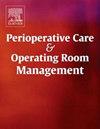Effects of intrathecal dexmedetomidine vs. magnesium sulfate on post-operative shivering for cesarean delivery: A double-blind randomized clinical trial
IF 1
Q2 Nursing
Perioperative Care and Operating Room Management
Pub Date : 2024-12-05
DOI:10.1016/j.pcorm.2024.100450
引用次数: 0
Abstract
Background
Considering the similarities and differences between dexmedetomidine and magnesium sulfate and understanding their mechanisms of action on shivering and thermoregulation, the authors proposed to compare the effect of intrathecal administration of dexmedetomidine and magnesium sulfate on shivering intensity in patients undergoing cesarean delivery surgery.
Methods
This study is a randomized, double-blind clinical trial, with two intervention groups and a parallel design. Patients randomized to Group D received 5 µg of dexmedetomidine plus 12.5 mg bupivacaine, group M received 25 mg magnesium sulfate plus 12.5 mg bupivacaine, and group C received 12.5 mg bupivacaine plus 1 ml normal saline 0.9 %. Physiological symptoms were recorded in the checklist by a research associate (blinded to the treatment group). Shivering intensity was evaluated by Tsai and Chu method. Physiological symptoms, the shivering intensity were recorded before (0) and 20, 45, 55 and 65 min after spinal anesthesia.
Results
GEE analysis of the study data showed a significant difference in the severity of shivering between the group dexmedetomidine and the group magnesium sulfate at different times (intervals) (p-value<0.001). Additionally, significance difference was observed between group control and group dexmedetomidine (p-value<0.001). The results of second model demonstrates that the patient in magnesium sulfate group were significantly six times more likely to experience shivering compared to dexmedetomidine group (OR =5.69, 95 % CI: 1.71–22.91, p-value<0.01).
Conclusions
Dexmedetomidine has a greater effect than magnesium sulfate on reducing the incidence of shivering and its severity in patients undergoing cesarean delivery.
鞘内右美托咪定与硫酸镁对剖宫产术后寒战的影响:一项双盲随机临床试验
背景考虑到右美托咪定和硫酸镁的异同,了解其对寒战和体温调节的作用机制,作者提出比较鞘内给药右美托咪定和硫酸镁对剖宫产手术患者寒战强度的影响。方法采用随机双盲临床试验,分为两个干预组,采用平行设计。随机分为D组:右美托咪定5µg +布比卡因12.5 mg; M组:硫酸镁25 mg +布比卡因12.5 mg; C组:布比卡因12.5 mg +生理盐水1 ml 0.9%。生理症状由一名研究助理(对治疗组不知情)记录在检查表中。寒战强度采用Tsai和Chu法测定。记录脊髓麻醉前(0)和麻醉后20、45、55、65 min的生理症状和寒战强度。结果研究数据的gee分析显示,右美托咪定组和硫酸镁组在不同时间(间隔)的寒战严重程度有显著差异(p值<;0.001)。另外,右美托咪定组与对照组之间存在显著性差异(p值<;0.001)。第二个模型的结果显示,硫酸镁组患者出现寒战的可能性是右美托咪定组的6倍(OR =5.69, 95% CI: 1.71-22.91, p值<;0.01)。结论右美托咪定降低剖宫产患者寒战发生率及严重程度的效果优于硫酸镁。
本文章由计算机程序翻译,如有差异,请以英文原文为准。
求助全文
约1分钟内获得全文
求助全文
来源期刊

Perioperative Care and Operating Room Management
Nursing-Medical and Surgical Nursing
CiteScore
1.30
自引率
0.00%
发文量
52
审稿时长
56 days
期刊介绍:
The objective of this new online journal is to serve as a multidisciplinary, peer-reviewed source of information related to the administrative, economic, operational, safety, and quality aspects of the ambulatory and in-patient operating room and interventional procedural processes. The journal will provide high-quality information and research findings on operational and system-based approaches to ensure safe, coordinated, and high-value periprocedural care. With the current focus on value in health care it is essential that there is a venue for researchers to publish articles on quality improvement process initiatives, process flow modeling, information management, efficient design, cost improvement, use of novel technologies, and management.
 求助内容:
求助内容: 应助结果提醒方式:
应助结果提醒方式:


